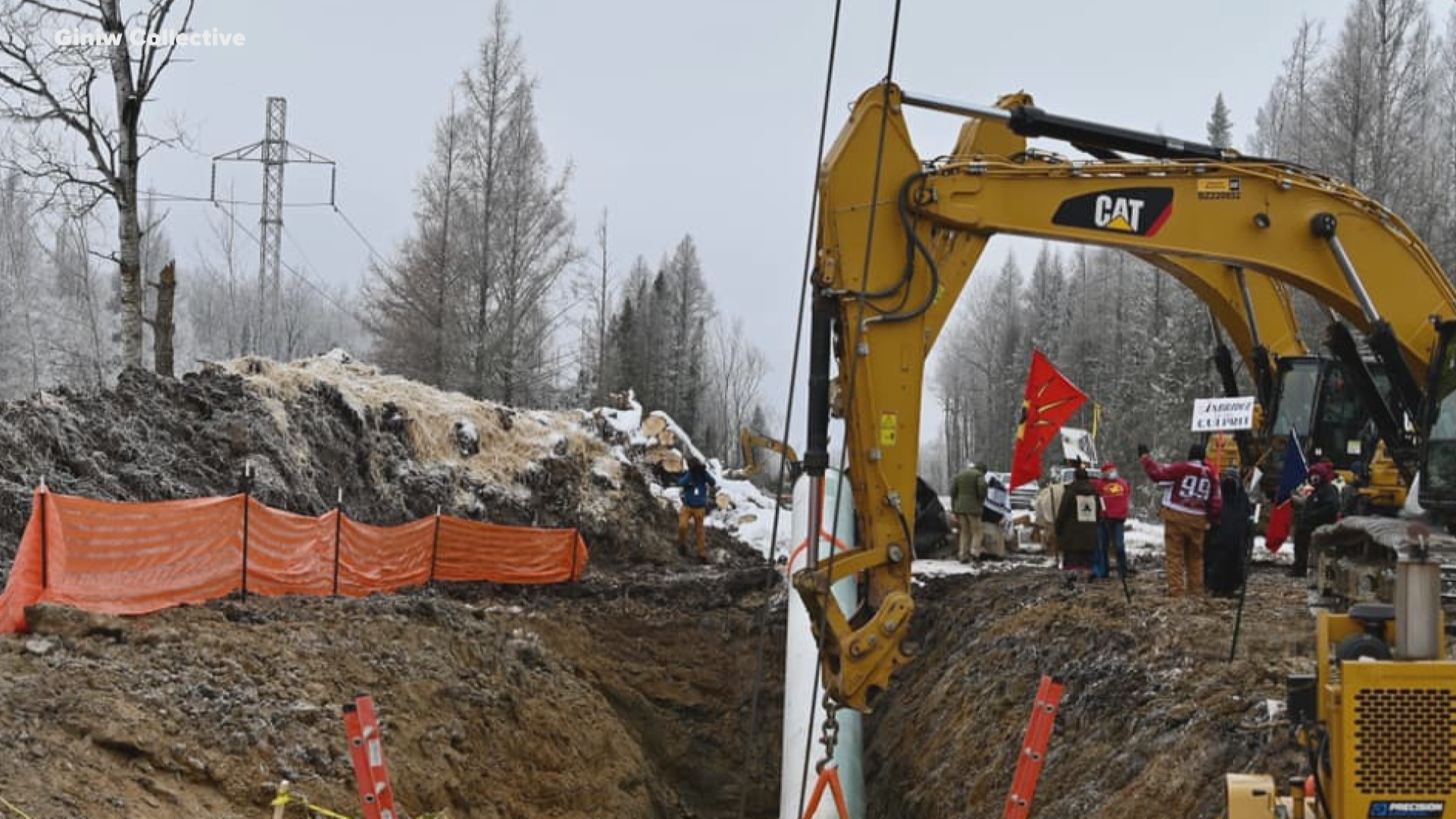CLOQUET, Minn. — The sounds of construction have echoed through the Fond du Lac Reservation this winter and early spring, as hardened union workers dig ditches and clear paths for the Line 3 replacement project.
To some, like Local 49 pipeline business agent Joshua Hegee, the buzz of heavy machinery represents a sign of progress, a step forward to replace an aging oil pipeline first built in the '60s. After six years of heated public hearings and stiff regulatory hurdles, the Canadian energy company Enbridge finally launched construction in December 2020 to rebuild 337 miles of Line 3 through northern Minnesota, putting thousands of workers on the ground with the mission of creating what they claim will be a safer, more efficient pipeline to send tar sands crude oil from Western Canada to Superior, Wisconsin.
“It makes me feel very happy,” Hegee said.
To others, the ringing noise of construction on the reservation represents an insult, a direct challenge to Native American land and, in their view, a major environmental risk. On the Fond du Lac Reservation, where Enbridge struck a deal with tribal leadership to replace the existing pipeline route, Indigenous rights activists bought property next to a work site and set up camp to oppose Line 3. They call themselves “Water Protectors,” often chaining their bodies to equipment to bring attention to their cause – not only on the Fond du Lac Reservation in Cloquet near Duluth, but also across Enbridge Line 3 sites in central and northwestern Minnesota. As a March public filing by Enbridge indicated: “Daily protest activity continues.”
Tara Houska, the founder of an Indigenous group known as Giniw Collective and an attorney born and raised in International Falls, has lived at one of these resistance camps for the past three years. Her sole goal is to stop Line 3.
“It’s total insanity,” Houska said in a Zoom call with KARE 11 from her camp, “and it’s a complete and utter violation of Indigenous treaty territories."
These opposing viewpoints have clashed ever since the regulatory process began in 2014, but they have only accelerated over the past four months due to the start of construction on Line 3. Local authorities have arrested dozens of activists, who support ongoing legal challenges to stop construction. So far, early in 2021, two court rulings have gone in Enbridge’s favor, although the Minnesota Court of Appeals just heard arguments this week from opponents that include the state’s own Department of Commerce. The company already completed pipeline reconstruction in Canada, North Dakota and Wisconsin, leaving Minnesota as the only state remaining (as of late March, the company said it’s halfway done).

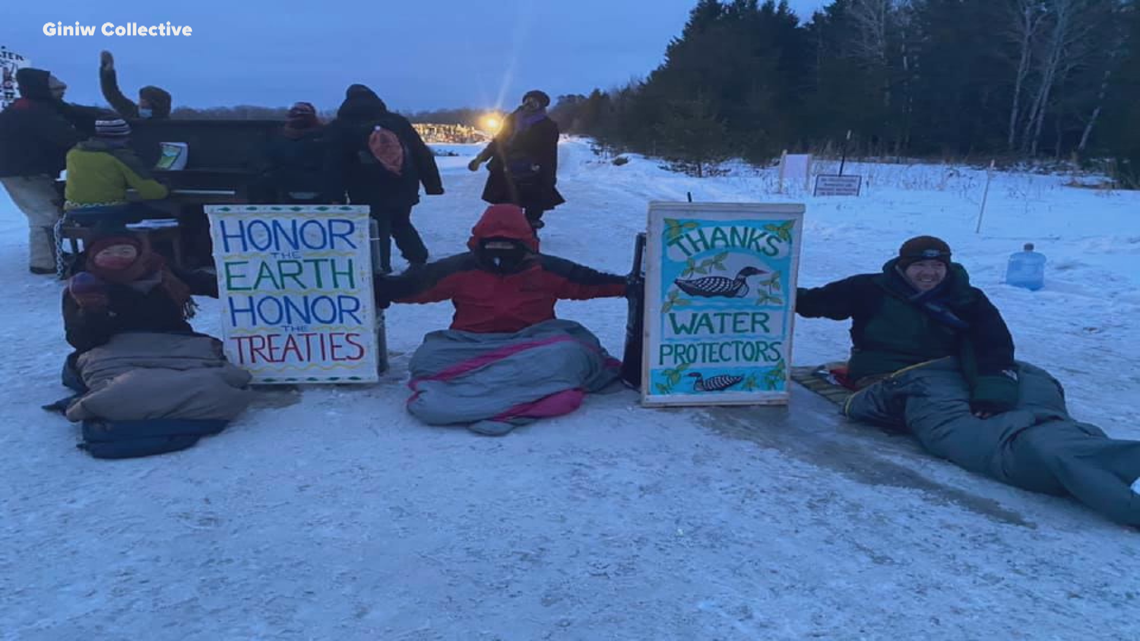
So, the work has continued in the Land of 10,000 Lakes, at a cost more than three times the scale of U.S. Bank Stadium. Enbridge expects the pipeline to be up and running, fully, by the end of 2021, after a temporary break in construction during spring thaw starting in April.
But the debate over one of the state’s largest construction projects in history – viewed by some as an economic game-changer, but by others as a danger to Native American culture and the earth’s climate – likely won’t go anywhere.
BACK TO WORK
In mid-February, KARE 11 drove north for two hours on Interstate 35 to visit the area known as “Spread Five,” a 39-mile stretch of the existing Line 3 pipeline in the northeastern part of the state. Spread Five runs from Floodwood, Minnesota, all the way to the Wisconsin border, representing the easternmost portion of the pipeline in the state of Minnesota. The Fond du Lac Band of Lake Superior Chippewa agreed in 2018 to let Enbridge replace this existing portion of Line 3 on its land instead of creating an alternate route through cherished treaty territories, even though leadership told a local newspaper it was “being forced to choose between two evils.”
Ryan Randolph arrived here from Des Moines, Iowa, at the start of November, weeks before construction officially began at this site near Cloquet. Among the one thousand members of IUOE Local 49 working on Spread Five, Randolph recently helped finish the clearing process near the pipeline and hopes to remain here for the duration of the construction.
“We’re just doing our day-to-day work of getting the job done. Safe and steady work,” Randolph said. “This is a very massive project.”

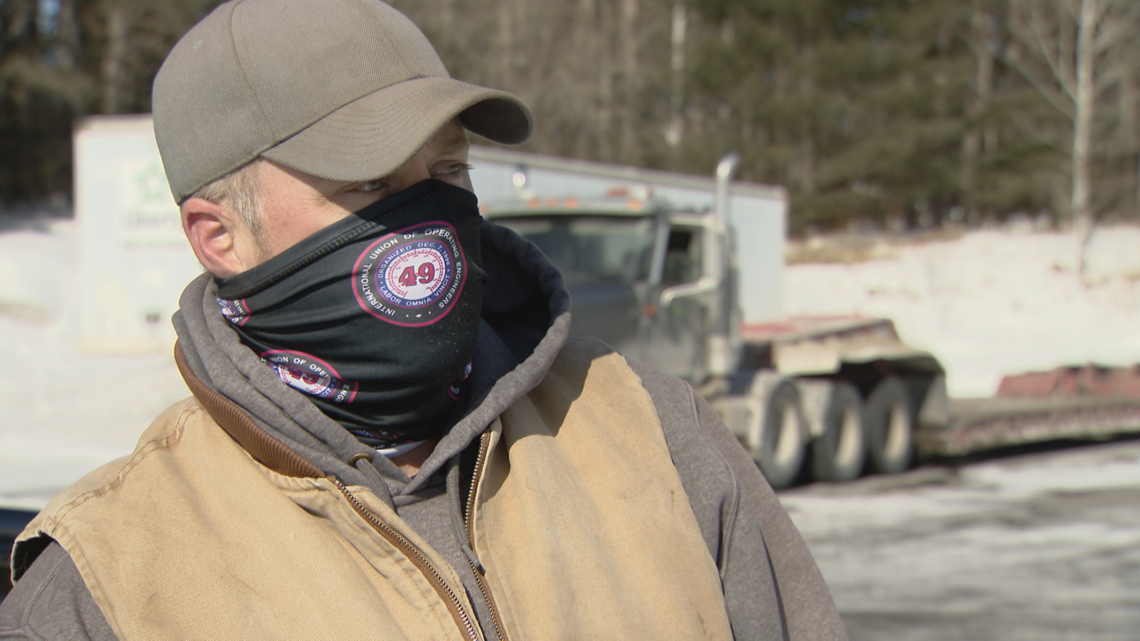
Randolph’s union jobs often take him across the country, but Line 3 offered an opportunity to work in a state that borders his own. According to a document filed with the state’s Public Utilities Commission last month, 1,553 of 4,664 workers (33%) at the end of December 2020 were listed as Minnesota residents, including 141 from Native bands, which has fueled arguments from project opponents that the Line 3 project doesn’t benefit the in-state workforce. A spokesperson for Enbridge, however, said in an email that it's a bit more complicated than the numbers suggest. That workforce total shows only the early winter construction period, and "in many cases local union halls include membership in neighboring states that was not necessarily counted towards the Minnesota workforce number."
Many of the out-of-state workers, regardless of the full demographic breakdown, are from the Midwest, including the Iowa native Randolph.
“This is the closest I’ve been able to work in my career,” Randolph said, noting that he can see his wife and children on short notice if needed. “People I work with are able to go home every night in their own beds. There are plenty of people who have never worked this close to home, and they’re ecstatic.”
Josh Hegee, the Local 49 pipeline business agent, hails from Two Harbors, Minnesota, located about an hour from the Spread Five site.
“This means a lot for the people in the area,” Hegee said. “A lot of these guys would be laid off right now. In three or four months they’re gonna put a big chunk of money in their pockets. This job could make a difference for people for years to come.”
Anecdotally, the surge of workers has brought some business to hotels, restaurants, and retail shops across Northern Minnesota at a time of great financial stress. In Cloquet, restaurant owners and hotel clerks said they have certainly noticed an increase in pipeline workers, while numerous letters to the editor have been written about the economic activity in tiny towns like Lake George and small hubs like Crookston.
“This is a very positive impact, not only for the members on this project, but also for the communities,” Hegee said. “When they have days off, they go ice fishing, they go have a burger, a beer. Positive all the way around.”

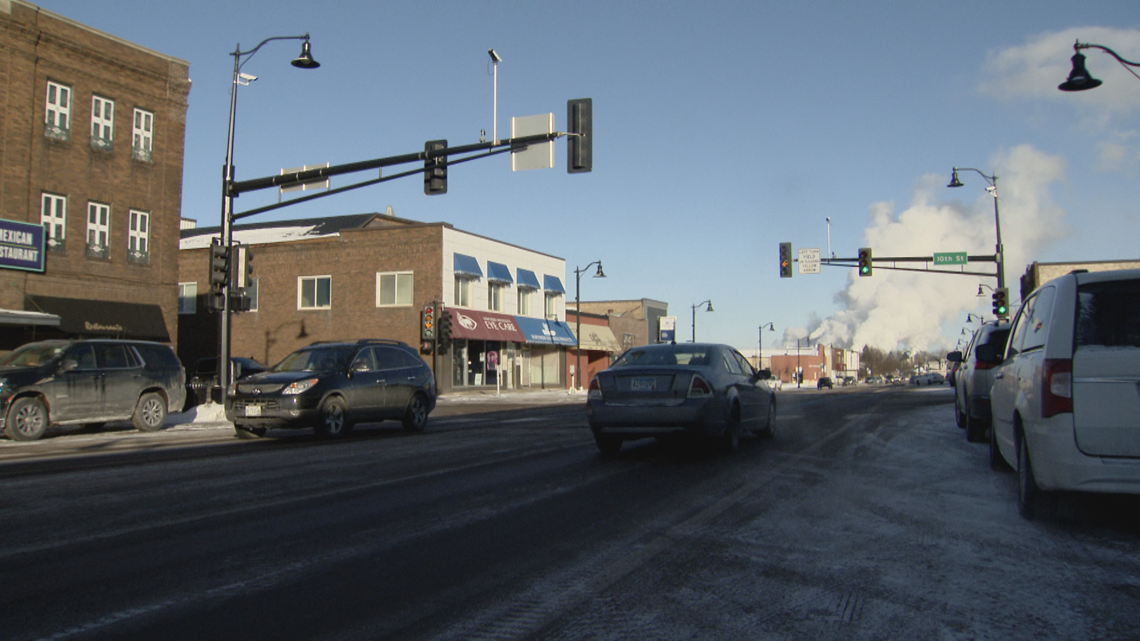
Opponents will argue that these jobs, and the overall economic activity, exist only in the short-term, and that the workforce does not solely benefit Minnesota workers. They are also alarmed by reports that two out-of-state pipeline workers have been arrested on various prostitution charges (one involving a minor).
Tara Houska, the Indigenous activist who grew up in Northern Minnesota, said she understands the need for job creation in her home state – just not through the oil industry.
“I would love to see investment from the state of Minnesota into these rural, beautiful places, the Land of 10,000 Lakes. Where’s the manufacturing jobs? Where’s the solar? Where’s the wind? Where are all these places and spaces that we could be creating, these really good long-term jobs?” she said.
For Houska, the fight against Line 3 is a deeply personal one, which is why she has spent the past three years living in a resistance camp about 200 yards from an Enbridge work site in northern Minnesota.
And she has help from many other “Water Protectors,” who are organizing protests across the 337-mile Minnesota pipeline portion to bring awareness to their cause.
WATER PROTECTORS
On Spread Five, water protectors have not merely organized. They bought property, within view of a construction site, to protest the project day and night at what has come to be known as “Camp Migizi”. KARE 11 visited the area in February, and although camp leadership did not authorize a tour, we spoke informally with some of the protesters as heavy machinery hummed within earshot.
Although they reserve most of their complaints for Enbridge and Line 3, the protest groups have also recently taken aim at Fond du Lac leadership, because it allowed the company to rebuild the pipeline on its reservation. Those two sides came into further conflict in February, when law enforcement authorities investigated a suspicious package thrown on a work site and evacuated neighbors due to concerns about a potential bomb. “To outside protestors instigating violence and violating Band law: Leave now,” Band Chairman Kevin R. Dupuis, Sr. said in a news release. “You are not welcome here.” Protest groups, meanwhile, questioned law enforcement’s version of events, with Camp Migizi’s Taysha Martineau saying: “The criminalization of water protectors and Indigenous leaders of the resistance is a tale as old as time immemorial. We stand with Camp Migizi.”
But Camp Migizi is just one example of resistance along Line 3. Similar camps, including the one where Tara Houska lives, have popped up across northern Minnesota, drawing significant media attention in recent weeks. Longtime celebrity activist Jane Fonda, for example, has featured both Houska and Representative Ilhan Omar (D-Minnesota) on her social media broadcast to discuss the ongoing developments with Line 3. In March, Fonda even traveled to Minnesota to see the pipeline for herself.
The “Water Protectors” and other opponents have vocalized a number of different complaints about Line 3, related specifically to climate change, the environment and Indigenous sovereignty. Building off the high-profile protests in 2016 over the Dakota Access Pipeline at Standing Rock, activists against Line 3 say Enbridge’s pipeline replacement route puts sacred lands at risk with the potential of an oil spill.

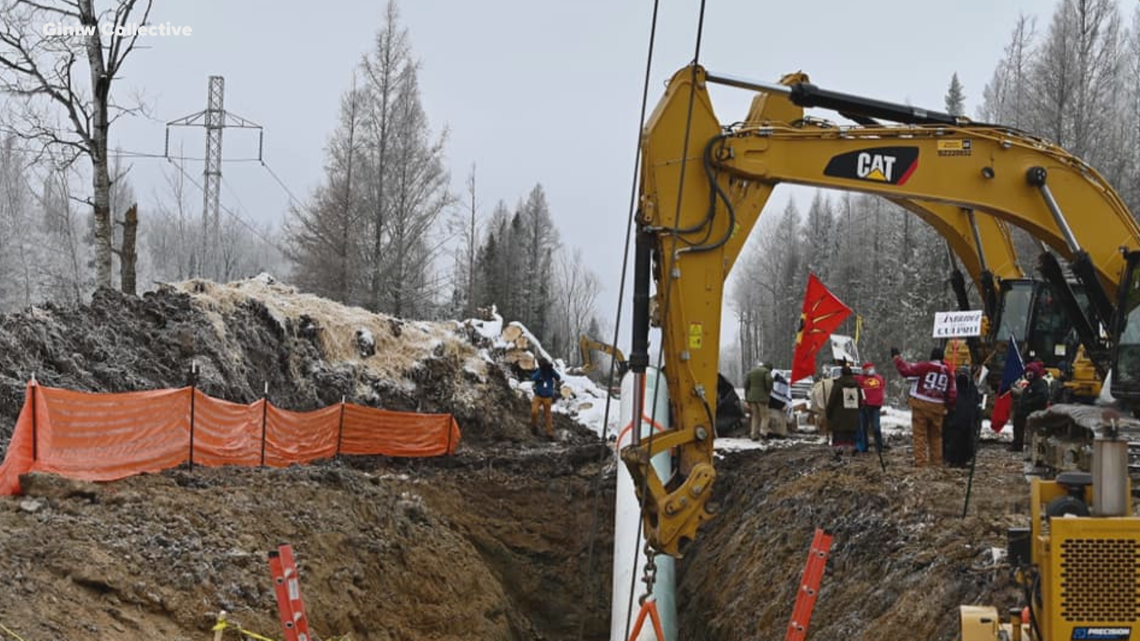
"We need to respect Indigenous sovereignty,” Houska said, “and we need to do that now.”
Starting in western Canada through North Dakota, the Enbridge replacement line runs through an existing route into northwestern Minnesota, then veers south and east on a brand new route over lands previously untouched, before finally again rejoining existing pipeline infrastructure in northeastern Minnesota. Ultimately, Line 3 spans all the way to Superior, Wisconsin. The company calls it a "replacement" because it's not a totally new build-out, while activists reject that term because the line crosses so many territories on a partially new route.
The full route bypasses the White Earth, Red Lake and Leech Lake reservations, but goes through areas where tribes have long-standing treaty rights for fishing and hunting, in addition to harvesting wild rice. A spill, many have claimed, could have devastating impacts.
"That wild rice is so sacred to our people,” Houska said. “It's at the heart of who we are. It is the center point of our culture, and our identity as a people.”
Multiple legal challenges are continuing, including one in federal court seeking a more robust federal environmental review.
The Minnesota Department of Commerce has also challenged the project repeatedly, on the grounds that oil forecasts don’t show a need for an enhanced pipeline and that the Public Utilities Commission should not have granted a Certificate of Need for the project. “The Commission failed to evaluate an energy demand forecast for crude oil as required by the certificate-of-need statute’s and rule’s plain language,” the Department of Commerce wrote in a court filing, “and shifted the burden of producing such a forecast to parties other than Enbridge.” Those arguments were heard in the Court of Appeals this week. A decision is expected within 90 days.
Although the courts, so far, have rejected attempts to stop construction, opponents are now pleading with the new administration in the White House as another last resort. On his first day in office, President Joe Biden revoked permits for the Keystone XL pipeline, a move that Line 3 resisters want to see happen again in Minnesota.
Rep. Omar sent one such letter to Biden, urging him to “Stop Line 3,” although the president has not replied as of yet. In an interview with KARE 11, Omar said these pipelines compromise the fight against climate change.
“Relying on a dirty fossil fuel, really is something that we need to move away from,” Omar said. “[It is] not going to allow us to sustain ourselves.”
Omar and others also point to Enbridge’s past record, specifically two of the largest inland oil spills in American history near Grand Rapids, Minnesota, in 1991, and Marshall, Michigan, in 2010.
But Leo Golden, the Vice President for Line 3 with Enbridge, said that history is more reason to do the replacement project.
“We don't bury the mistakes we've made,” Golden said. "It's lessons like Grand Rapids and Marshall that get us to the point of saying, you know, we could continue to operate this, but it's better to replace it."
ENBRIDGE: “THIS PROJECT IS ABOUT SAFETY.”
Through six years of public hearings, Enbridge has consistently maintained that the replacement of Line 3, which is more than a half-century old, will ensure safety of the pipeline for decades to come. Enbridge has rejected the notion that the project further contributes to climate change, and the company has published a “Net Zero by 2050” plan that it makes available on its website.
In a Zoom interview from Canada with KARE 11, Golden pushed back against claims made by activist groups by pointing to the long regulatory process.
“It demonstrates that this project does not exacerbate greenhouse gas emissions. The crude oil that will move through this pipeline is currently being produced and being moved by other means. Today, you see hundreds of thousands of barrels a day of oil being moved on rail, and it can be moved on trucks as well,” Golden said. “It's best to get it back into a pipeline. Pipelines are the most efficient and safest way to move this product.”
With construction continuing throughout northern Minnesota, Enbridge expects work to finish by the fourth quarter of 2021. Construction crews – and activists – will therefore stay busy for many months after a temporary break for the spring thaw.
Josh Hegge of Local 49 said he hopes more people will appreciate the economic benefits of the project – including those who have set up camps near the construction sites.
“The people that don’t really feel the project needs to go, that’s their opinion and I respect it, but as long as they do it in peaceful manner,” Hegee said. “We have a lot of members out here away from families.”
Indigenous activist Tara Houska does not begrudge any of the workers on a personal level, but she said simply that the Line 3 pipeline is an affront to her people.
"We've been dealing with this for hundreds of years,” Houska said, “and it's time to change."

